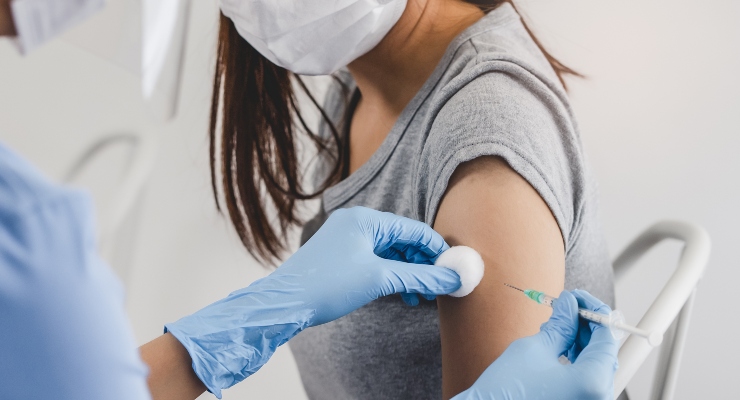
The Australian Technical Advisory Group on Immunisation (ATAGI) loves a preference, and this single word “preferred” has driven much of the uncertainty around what any given individual should actually do.
ATAGI holds that AstraZeneca is not the preferred vaccine for people aged under 60, but a preference is not a directive. It’s not even a recommendation. It’s slightly stronger in meaning than the serving suggestion on the box of a Lean Cuisine.
ATAGI’s use of waffly language is deliberate. If we’re being generous then that makes sense because it is difficult to make strict prescriptions about the delivery of a new vaccine we’re still learning about in a dynamic setting where one’s risk of infection can change in a day. Also if one month’s firm, confident recommendation turns out to be incorrect, there won’t be much trust in the next recommendation.
The new position held by ATAGI is that an interval of four to eight weeks between doses of AstraZeneca is preferred (there’s that word again) in an outbreak setting. The efficacy of the AstraZeneca vaccine is greatest with a >12-week interval between doses (>80% efficacy) and drops when the doses are closer together (55% efficacy for <6-week interval). Efficacy refers to the reduction in symptomatic cases of COVID-19 among vaccinated people vs the number of cases in non-vaccinated people in a given time period.
Studies have found a relationship between clinical trial efficacy and the level of an individual’s COVID-19 antibodies and eventually we will be able to accurately assess someone’s immunity with a blood test, as we currently do for diseases such as hepatitis B and rubella.
The key question now: is it better to have protection sooner at the expense of protection longevity or do you wait longer with less protection and get better longevity? Also, what’s the difference between waiting four weeks or eight weeks for the booster? A lot can happen in four weeks and this gaping window opens another front of uncertainty.
In short, the efficacy of an eight-week booster is about 60%, which is not that different to the four-week interval’s 55%. If someone has already decided to get an early booster, there isn’t much to be gained by quibbling over a measly 5% efficacy. ATAGI could help offset a lot of uncertainty by just calling it four weeks for an early booster.
As for whether it’s better to get earlier or longer lasting protection, that seems to be a question the people of Greater Sydney are answering with their feet. Most people want any vaccine as soon as possible and the likely availability of future boosters or revaccination with an mRNA vaccine means there isn’t much incentive to hold out for longevity.
Another recommendation from ATAGI is that people under 60 in an outbreak setting who cannot access an mRNA vaccine “reassess the benefits to them” by being vaccinated with AstraZeneca. Again, not prescriptive language but the decision for people aged 20-50 can be reduced to two numbers. The risk of thrombosis with thrombocytopenia syndrome (TTS, a treatable condition) from AZ is 3 in 100,000. The chance of dying from COVID if infected is 120 in 100,000. I know what my preference is.
Mitchell Squire is a GP and a visual satirist for Crikey.








I’ll be waiting 12 weeks for the second AZ vaccination. But that is because I live in Perth. I may change my mind.
If you’re sensible you will. Check at least first 10 min of this – https://tinyurl.com/vhb7bjk .FREE STREAMING of Dr. Gary Null’s award winning film DEADLY DECEPTION
Good idea, 12 weeks gives the most protection.
Well, hell’s bells …your opinion differs , as a medical professional, to that of my husband’s GP, who is apparently telling his patients, he/they (at his practice) will stick with the, “original advice” about AstraZeneca (twelve weeks after the initial dose ).
We are so fortunate here in Oz, to have the, “AstraZeneca chief” , Pascal Soriot, living in Sydney since 1990 and constantly supporting our economy (his wife swept up a bargain at Mosman recently, with a $4m property, to add to the family portfolio…with the Domain reporter, jokingly suggesting they, “didn’t require finance” … Soriot earns $27.5m annually and is a dual French-Australian citizen, not himself, currently in Oz.
No wonder people don’t trust this lousy, rotten, corrupt government.
Reading the article in Domain, I finally understood why the government was constantly favouring one vaccine over the other…and now ATAGI is showing bias toward AstraZeneca and changing the rules accordingly.
Little wonder people are confused.
Want another reason why AZ was the preferred vaccine? Kieran Schneemann is the key. https://uat.crikey.com.au/2020/08/20/from-lib-staffer-to-big-pharma-an-unsurprising-journey-of-lobbying-at-work/
Is there any reason why you can’t get three shots? Why not the first one today, a second in 4 weeks, and a third in 12 weeks?
https://theconversation.com/do-i-need-a-covid-19-booster-shot-6-questions-answered-on-how-to-stay-protected-164053
The risk balance benefit of Pfizer and AZ vaccinations quickly change when the virus gets out into the community. ATAGI’s conservative recommendations, made at a time of very low virus prevalence in the community, have been one of many own goals in the efforts to get Australians vaccinated.
Interesting that the media shows the ruthless bit of excrement Berjiklian in flattering photos, but Dan, McGowan not, despite her unleashing the virus twice on the whole nation.
in Sydney, at least 70 ambulance workers are isolating after a paramedic in the south west of Sydney tested positive to Covid. A NSW Ambulance spokesman said the worker is believed to have caught Covid in the community, not at work.
Separately, NSW Ambulance is investigating further reports of other ambulance workers who have tested positive but have had no contact with the confirmed case.
I don’t know how many are soothed by the worried concerned fake Shredder look she manifests, but many will understand her reportage of numbers infected are the tip of the iceberg; bodgy numbers being a game the Coalition is familiar with, in this case it’s a fraction of what’s out there, those who’ve fronted up to be tested only.